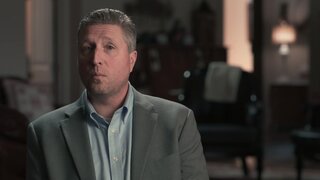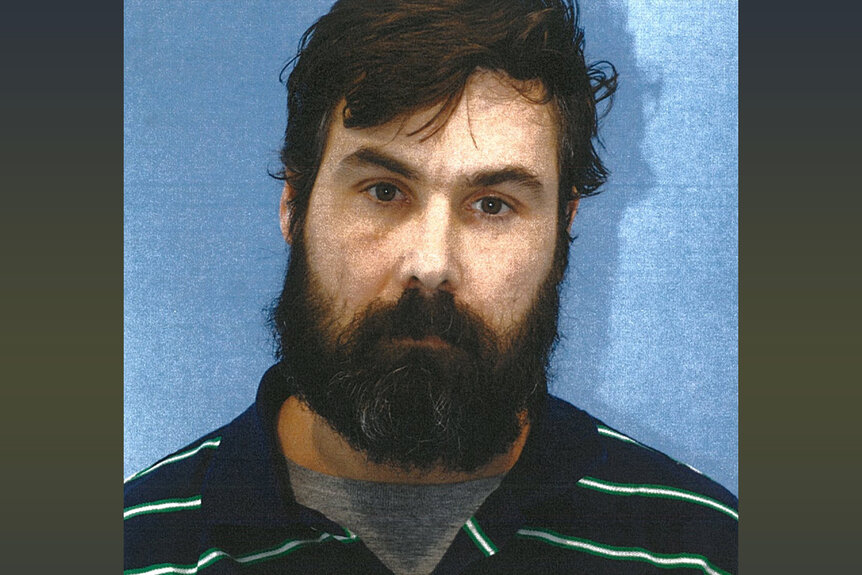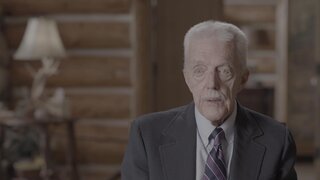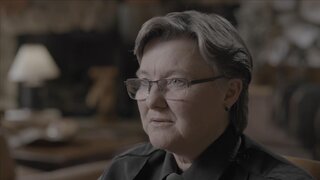Create a free profile to get unlimited access to exclusive videos, breaking news, sweepstakes, and more!
Elderly California Man Strangled and Found Buried Inside a Giant Concrete Egg
Being pen pals with prison inmates, a detective said, put the victim “in the path of a potential predator."
On September 5, 2008, San Diego police received a 911 call from a resident reporting a dead body inside a large ornamental concrete egg in his garden. He had cracked the orb open with a sledgehammer.
“I’ve seen my fair share of dead people in weird places,” Jim Peters, an investigator with Riverside County Sheriff’s Department, told Buried in the Backyard, airing Saturdays at 8/7c on Oxygen. “This is a first.”
An autopsy conducted the next day showed that the “mummified” male victim had been bent and bound into the fetal position. He had a belt around his neck. Who was he?
80-year-old Edward Andrews Goes Missing
The answer was tied to a case in Riverside County, some 90 miles away in Hemet, California where 80-year-old Edward Andrews lived.
In his younger days, Andrews, who worked for an oil company, had married his high school sweetheart and raised four children.
Then, in 1968, the couple split. “That’s when we pretty much discovered that my dad was gay,” said Andrews’ daughter, Linda Runions.
“It took a lot of courage,” said her brother, Terry Andrews. He called their dad “a wonderful human being.”
RELATED: Single Dad Lured To Texas Desert Was Beaten and Buried Alive: "That's Pure Evil"
In the spring of 2008, Runions and her husband bought a home in Hemet to be close to her aging father. Soon after, on June 4, Andrews’ neighbor called and said he couldn't get in touch with him, so the Runions contacted the Riverside County Sheriff’s Department to file a missing person report. “The neighbor saw him on May 31, and now it is June 4. He could have been missing for five days already,” said Peters.
Sheriffs made a wellness check and found nothing amiss at Andrews’ home.
His neighbors, the Grahams, however, had key information. They recalled Andrews’ friend, Jeffrey Sterling, being dropped off at 8 a.m. in a white car at the residence on May 31. Around noon, they saw Andrews leave in his silver Saturn.
Officials’ efforts to contact Sterling were unsuccessful. On June 5, the Grahams came to the Hemet station with a letter they’d received that day in the mail. In it, Andrews allegedly wrote that he and Sterling were “very much in love” and going to Europe and South Africa, according to investigators. The letter was riddled with grammar and spelling errors.
Jeffrey Sterling Becomes "Centerpiece" in the Case
Detectives and Andrews’ family believed it was a fake. Nonetheless, Sterling became “the centerpiece” of the case, said Peters.
Investigators returned to Andrews’ home, where they found the telephone answering machine flashing, said Dean Spivacke, a sergeant with Riverside County Sheriff’s Homicide Unit.
One message was from a bank, which was checking on a recent transaction. There were more messages, including “a forceful one” about money and instructing Andrews to check his mail.
Investigators discovered that Andrews had a P.O. box. At this point, the Inland Regional Apprehension Team (IRAT), which is made of officers with the FBI, got involved. “They are literally bloodhounds,” said Spivacke of IRAT.
Edward Andrews was a pen pal with inmates
The P.O. box contained numerous letters from people at California correctional institutions. “Ed has been corresponding with these inmates,” said Spivacke, adding that correspondence included financial information.
Andrews had been a Methodist pastor and seemingly tried to give the inmates some guidance, according to investigators. But Andrews had put himself “in the path of a potential predator," said Peters.
RELATED: South Carolina Man Was Shot 8 Times, Buried Twice, and Dumped in Lake in "Vigilante" Murder
On June 22, detectives learned from IRAT that $92,000 had been withdrawn from Andrews’ bank account. ATM footage captured an unidentified man arriving at the bank in a white Prius and taking money out of Andrews’ account.
Detectives put out a press release with a photo of the man at the bank to generate leads. Upon seeing the photo, the Grahams said that the man was Jeffrey Sterling.
Jeffrey Sterling Was Really the Fugitive Thomas Brooks
Runions informed investigators that her father had left letters and photos in her home in Hemet. The evidence revealed that Sterling was actually Thomas Jeffrey Brooks, who had a criminal history and had been incarcerated.
Letters between Andrews and Brooks began politely and had grown more personal over time. Brooks was released in 2007, at which point he went on the lam instead of reporting to a halfway house.
In August, IRAT observed activity using Andrews’ account in San Diego. Officials managed to take Brooks into custody, along with the man who had driven him to the bank.
When investigators asked Brooks how he knew Andrews, Brooks can be heard in the recorded interviewer saying that he “started writing to him in prison. You already know that.”
“Ultimately, he admits that Ed is dead,” said Spivacke. “When asked how Ed died, Brooks said ‘probably from lack of air.’”
But Brooks wouldn’t say where Andrews’ body was and asked for a lawyer.
Detectives then questioned the driver, Arlo Elizarraraz, who knew Brooks by the name of Josh Meyers. He said he didn’t know anything “about what was going on,” said Paul Conley, a detective with the San Diego PD. Elizarraraz was released the same day.
Detectives searched Brooks’ San Diego apartment. The landlord, Ben Mason, knew Brooks as Josh Meyers. Investigators found Andrews’ license and credit cards, as well as a computer setup for printing checks, in Brooks’ residence.
In addition to fraud and theft, Brooks was charged with first degree murder a special circumstance of financial gain. Brooks was eligible for the death penalty.
On August 13, prosecutors prepared to bring Brooks to trial. There was clear evidence of fraud and theft, but Andrews’ body hadn’t been found.
“No-body homicides are really difficult to prosecute,” said Spivacke. “We knew that Ed was dead. But we didn't know for sure how he died or where his body was.”
$92,000 Reason Edward Andrews' Body Was Found
Reports of the Andrews case made the news. They included that Brooks may have taken nearly $100,000, said Paul Conley, a detective with San Diego Police Department.
On September 5, San Diego PD got the 911 call about the dead body in a concrete egg. The homeowner who made the call was Brooks’ landlord.
Detectives learned that in June 2008, Brooks had offered to put in a rock garden at Mason’s home for a break in rent. The installation included a giant oval made out of chicken wire and cement.
After hearing news accounts about Brooks and the missing fortune, Mason broke open the massive egg in search of the hidden fortune. It wasn’t there, and has never been found. Instead, he found the decomposing body posed in the fetal position, later confirmed through DNA to be Ed Andrews. The cause of death was asphyxiation.

Investigators interviewed Elizarraraz again. He told them that he responded to Brooks’ Craigslist ad for a driver.
Detectives theorized that Brooks strangled Andrews at his apartment in San Diego. After binding Andrews in a fetal position and stuffing him into a large plastic tub, they believed Elizarraraz helped load the container into a car and drove to Mason’s home.
“We learned that Arlo helped construct this egg with Brooks,” said Conley. Elizarraraz was charged with being an accessory to murder.
He was offered a plea deal in exchange for testimony against Brooks. In March 2010, Elizarraraz was sentenced to nine years in prison.
As Brooks’ trial approached, he attempted to kill himself while behind bars. Brooks, 40, survived and was convicted and sentenced to 75 years to life in prison.
To learn more about the case, watch Buried in the Backyard, airing 8/7c on Oxygen.




































